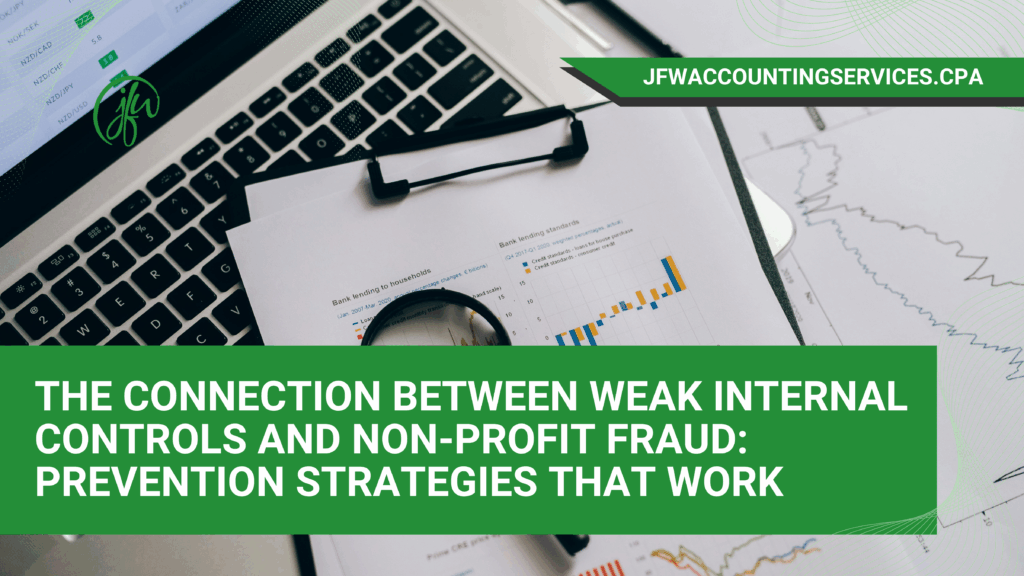Picture this: A respected community non-profit discovers that their beloved volunteer coordinator has beePicture this: A respected community nonprofit discovers that their beloved volunteer coordinator has been skimming donation checks for months. The organization trusted her completely—she’d worked there for years and seemed genuinely committed to the cause. What they didn’t realize was that their trust-based culture, combined with one person handling all aspects of cash processing, created the perfect opportunity for fraud. This scenario plays out more often than most board members would like to admit, and it highlights why nonprofit fraud prevention requires more than good intentions and trust-based culture.
Common Fraud Scenarios and Their Root Causes
Cash theft represents the most frequent type of fraud in nonprofit organizations. This occurs when employees divert cash receipts before they enter the accounting system. The weakness typically stems from having a single person handle all aspects of cash processing—from receiving donations to making deposits.
Internal controls for nonprofits require specific attention to these vulnerabilities, as documented by the Council of Nonprofits.
Expense reimbursement fraud happens when employees submit false or inflated receipts for personal expenses. nonprofits often lack proper documentation requirements or approval processes for expense claims, making this fraud easier to commit and harder to detect.
Ghost employee schemes involve creating fictitious employees on payroll or keeping terminated employees in the system. Small nonprofits with limited HR oversight and manual payroll processes are particularly vulnerable to this type of fraud.
Grant fund misappropriation occurs when organizations use restricted funds for unauthorized purposes. This often results from poor tracking systems and inadequate segregation of duties in financial management.
Nonprofit Fraud Prevention Strategies That Work
Implement Segregation of Duties
Even small organizations can establish basic segregation of duties. The person who receives cash should not be the same person who records the transaction or makes bank deposits. For organizations with limited staff, consider rotating responsibilities monthly or requiring two-person teams for cash handling.
Create a simple matrix showing who can authorize, record, and review different types of transactions. This visual tool helps ensure no single person controls an entire financial process.
Establish Clear Approval Hierarchies
Set spending limits that require multiple approvals. For example, expenses under $5,000 might need supervisor approval, while amounts over $10,000 require board approval. Document these limits in writing and ensure all staff understand the process.
Create standardized forms for different types of expenditures, including detailed fields for justification and supporting documentation.
Regular Bank Reconciliations
Perform bank reconciliations monthly by someone who doesn’t handle cash or write checks. This simple control can catch unauthorized transactions quickly. For added security, have the executive director or board treasurer review reconciliations.
Use online banking alerts to notify multiple people of large transactions or unusual account activity.
Surprise Audits and Reviews
Conduct unannounced cash counts quarterly. This deters theft and catches discrepancies early. Similarly, perform random reviews of expense reports and vendor payments to verify authenticity.
Consider hiring an external accountant to perform annual reviews, even if a full audit isn’t required.
Technology Solutions for Fraud Prevention
Modern accounting software provides built-in controls that weren’t available years ago. Cloud-based systems like Sage Intacct offer automatic approval workflows, real-time reporting, and audit trails that track every transaction.
Electronic payment systems reduce cash handling and create automatic documentation. Direct deposit for employees and ACH payments to vendors leave clear digital trails.
These nonprofit fraud prevention tools create multiple layers of security that manual processes cannot match.
Document Everything
Develop written policies covering all financial processes. Include specific procedures for handling donations, paying expenses, managing petty cash, and processing payroll. Make these policies accessible to all staff and board members.
Require supporting documentation for all transactions. This includes receipts, invoices, contracts, and approval forms. Store documents electronically to prevent loss and improve accessibility.
Board Oversight Responsibilities
The board should review financial statements monthly, not just annually. Focus on budget variances, cash flow, and any unusual transactions. Board members with financial backgrounds should serve on the audit committee.
Require the executive director to present a financial summary at each board meeting, including explanations for significant variances from budget.
Training and Culture
Train staff on proper procedures and the importance of internal controls. Make it clear that these measures protect the organization and all employees, not just prevent fraud.
Create an environment where staff feel comfortable reporting concerns without fear of retaliation. Establish a confidential reporting mechanism for suspected fraud.
Implementation for Different Organization Sizes
Small organizations with under five employees can implement basic controls by:
- Using two signatures on checks over a set amount
- Having different people handle cash and record transactions
- Performing monthly financial reviews with board involvement
Medium-sized organizations should add:
- Formal approval workflows
- Regular internal audits
- Professional accounting software with user permissions
Large organizations need:
- Dedicated internal audit functions
- Comprehensive policy manuals
- Annual external audits
Monitoring and Continuous Improvement
Review and update internal controls annually. As organizations grow and change, so should their control systems. Stay informed about new fraud schemes and update your nonprofit fraud prevention procedures accordingly.
Track key indicators like expense-to-revenue ratios, cash-to-total asset ratios, and budget variances. Unusual changes in these metrics can signal potential problems.
Strong internal controls protect more than money—they safeguard your organization’s reputation and mission. While implementing these measures requires time and effort, the cost of fraud far exceeds the investment in prevention. Start with basic controls and build up your system over time.
Ready to strengthen your nonprofit’s financial controls? Contact us today to learn how we can help protect your organization from fraud while maintaining compliance with donor restrictions. Our team specializes in designing internal control systems that work for nonprofits of all sizes, plus we offer technology solutions like Sage Intacct to automate and strengthen your financial processes. Let us help you focus on your mission while we ensure your financial integrity.

Jo-Anne Williams Barnes, is a Certified Public Accountant (CPA) and Chartered Global Management Accountant (CGMA) holding a Master’s of Science in Accounting (MSA) and a Master’s in Business Administration (MBA). Additionally, she holds a Bachelor of Science (BS) in Accounting from the University of Baltimore and is a seasoned accounting professional with several years of experience in the field of managing financial records for non-profits, small, medium, and large businesses. Jo-Anne is a certified Sage Intacct Accounting and Implementation Specialist, a certified QuickBooks ProAdvisor, an AICPA Not-for-Profit Certificate II holder, and Standard for Excellence Licensed Consultant. Additionally, Jo-Anne is a member of American Institute of Certified Public Accountant (AICPA), Maryland Association of Certified Public Accountants (MACPA), and Greater Washington Society of Certified Public Accountants (GWSCPA) where she continues to keep abreast on the latest industry trends and changes.

